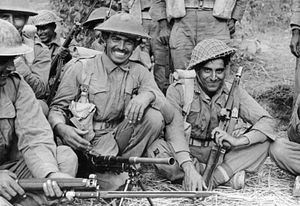Christopher Nolan’s new film Dunkirk, depicting the defeat and evacuation of British and allied forces from France in May and June 1940, has caused a fierce backlash among Indian commentators and a number of historians because it allegedly fails to depict the “significant contribution” the Indian Army made to victory in World War II.
To some commentators the failure to depict Indian soldiers at Dunkirk (three companies of the Royal Indian Services Corps, a little over 1,000 men) feeds into the alleged misconstrued British narrative that Great Britain fought World War II alone. “Britain didn’t fight World War II — the British Empire did,” the historian Yasmin Khan wrote in a recent op-ed in The New York Times, claiming that Indian soldiers in France in 1940 played a “significant role, ferrying equipment and supplies.”
Based on the historical record, however, the Indian Army militarily played no significant role in Europe in 1940, especially not during the Dunkirk evacuation. (The Indian Army would of course prove crucial to British victories in East Africa, North Africa, the Middle East, and Southeast Asia.)
First, rather than Indian or British forces, French units — the 2nd Light Mechanized Division, 68th Infantry Division (mostly containing older reservists), and above all the 12th Motorized Infantry Division — all in all around 30,000 men, including French North African units, kept the Germans from crushing the defensive perimeter in the first days of June 1940. This staunch French defense allowed for the evacuation of the three companies of the Royal Indian Services Corps, along with over 300,000 allied troops. It is unclear what “huge part” Indian soldiers played during the Dunkirk evacuation, although they were reportedly commended for their coolness under fire. However, over 50,000 Lascars from India served on British merchant ships, around 20 percent of total personnel serving in the British Merchant Navy in 1940, some of whom participated in the evacuation.
Second, Indian military forces did not significantly contribute to one of the most important fights in Europe in 1940: The Battle of Britain. While it is true that 18 brave Indian pilots (some sources say 24) joined the Royal Air Force in 1940 (seven of which would become fighter pilots), they did not complete their combat training until April 1941, after the end of the battle, although in time to participate in the last phase of the so-called Blitz. In comparison, over 140 Polish, 127 New Zealander, 112 Canadian, and around 30 Belgian pilots fought during the Battle of Britain. In fact, the Royal Indian Air Force consisted of one fighter squadron in the summer of 1940 (the Royal Air Force had six other squadrons stationed in India) and was tasked with primarily guarding India against a possible Russian attack during that time. The Royal Indian Air Force would expand to ten squadrons and over 30,000 men by 1945.
Third, no Indian Army troops were specifically dispatched to Europe for the defense of Great Britain in 1940 following the fall of France (the three companies of the Royal Indian Services Corps evacuated from Dunkirk stayed in the country until 1943). This is perhaps an obvious point, but should be reiterated nonetheless: The Indian Army was primarily responsible for the defense of India. Other duties included internal security and guarding British imperial possessions. (Consequently, immediately prior to the outbreak of World War II, India sent out around 10,000 men to Aden, Egypt, Iraq, Singapore, and Kenya, which were part of India’s sub-imperial system.) Also, during the first year of the war, Indian army units were short of everything from rifles to boots and lacked motor transport, not to mention modern tanks and artillery.
Fourth, when talking about the Indian Army, during that time it is important to realize that Indian units could contain entire British battalions. In fact, the Army of India consisted of the British Indian Army and the British Army in India, the former consisting of units raised in India primarily commanded by British officers (and often British non-commissioned officers), the latter of British units stationed in India for a tour of duty. When reading World War II accounts, it is thus often difficult to discern the ethnic composition of division-sized Indian Army units. For example, the famed 4th Indian Infantry Division, the first Indian Army unit to be sent to the frontline, consisted of two infantry brigades, each of which was further subdivided into two Indian and one British infantry battalions. Indeed, the 4th Indian Infantry Division would be reinforced by an entire British brigade and a British tank regiment during its service in East Africa in 1940 and later in the Middle East.
The Indian Army made a discernible impact during World War II, but not during Operation Dynamo. It is easy to see a film like Dunkirk as perhaps a vicarious and latent continuation of institutionalized racism (the apparent underlying charge by some commentators) once prevalent in many British possessions East of Suez (perhaps most blatantly laid bare during the British defeat in Burma in 1942, as I wrote in a piece for The Diplomat Magazine last year). However, in the case of the film Dunkirk, historical facts and the rather small role played by three companies of the Royal Indian Services Corps during the evacuation do not support such an indictment.

































